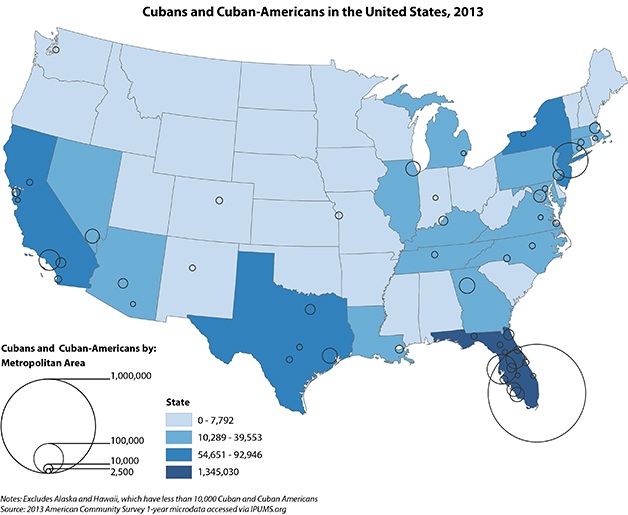The first high-level talks between Cuba and the United States in 35 years were held this week in Havana and migration emerged as a contentious issue. Cuban officials urged the American delegation to end its policy of allowing Cubans who reach U.S. soil to stay as refugees, saying it is a dangerous enticement. U.S. officials maintained that the policy will remain in effect.
Despite their decades-long estrangement, the two countries have cooperated on the issue of Cuban migration to the United States in some ways over the last two decades. The current United States immigration policy that treats migrants from Cuba differently than migrants from any other country will likely evolve as the two countries attempt to re-establish relations.
Many Cubans seeking entry to the United States attempt to arrive without permission by sea, facing dangerous conditions often in rickety craft. Those who make it are admitted to the United States, and may apply for legal permanent residency one year later. Those stopped at sea by the U.S. Coast Guard are screened to see if they meet refugee requirements. If so, they are sent to a third country; if not, they are returned to Cuba.
This “wet-foot, dry-foot” policy has been in place since agreements dating to the “Balsero” migration of 1994 and 1995, and will remain in effect unless Congress acts to change it. Others arrive in the United States through legal means, mostly through refugee and asylum channels and a visa lottery program that allows 20,000 Cubans entry every year.
While changes to immigration policy are not imminent, the recent diplomatic opening prompted an increase in the number of Cuban emigrants attempting to make their way to the United States by sea, fearful that the lenient policy will end. The U.S. Coast Guard reports nearly 500 Cuban migrants were picked up at sea in December, more than double a year ago.
Given pent-up demand for family reunification and the strong ties among Cubans and Cuban-American communities in the United States, what might be the impact on U.S. settlement if Cubans are treated like other immigrants?
Nationwide, 2 million people (3.7 percent) of all Hispanics or Latinos identify as Cuban. Here are a few salient facts about Cubans—those born on the island—and Cuban-Americans—those born in the United States who claim Cuban identity:
- Where they were born: Nationally, 57 percent of Cubans/Cuban-Americans are foreign-born. This share is higher in Florida, where 65 percent were born abroad. It comes as little surprise that in Miami Cuban immigrants make up a higher-than-average share (69 percent) of all those identifying as Cuban, but there are also metro areas outside of Florida with high shares: Louisville (83 percent), Houston (68 percent), Phoenix (62 percent) and Las Vegas (60 percent).
- When they arrived: Nationally, just over half (55 percent) of all Cuban-born immigrants arrived prior to 1996 when the current wet-foot, dry-foot policy was fully implemented, and the remaining 45 percent arrived since. In metropolitan Chicago, Washington, D.C., New York and Los Angeles the share of the Cuban population that has been in the United States before 1996 is even higher, ranging from 72 percent to 89 percent respectively. In Tampa, Las Vegas, Cape Coral, Houston and Louisville, the share that has arrived since 1996 is much higher, ranging from 59 percent to 91 percent respectively.
- Where they live: More than two-thirds (68 percent) of all Cubans and Cuban-Americans nationwide live in Florida with a majority (54 percent) of the population living in metropolitan Miami. Eighteen (18) percent of Miami residents identify as Cuban. Elsewhere in Florida, Cuban communities are strong in metropolitan Tampa (96,000), Orlando (40,000), Cape Coral (21,000), Jacksonville (13,000) and Lakeland (10,000). Outside of Florida, the largest numbers of Cubans and Cuban-Americans reside in the New York metropolitan area (138,000, which includes counties in New Jersey with large numbers) and Los Angeles (49,000). Atlanta, Houston, Chicago, Las Vegas and Washington, D.C. are also home to between 15,000 and 30,000 Cubans and Cuban-Americans each.

- How old they are: Sixty-three (63) percent of Cubans and Cuban-Americans are working age (18 to 64), the same share as the United States overall. However, a greater share is 65 and older: 17 percent of Cubans and Cuban Americans compared to 14 percent of the United States as a whole. Younger Cubans are less concentrated in Miami. Sixty-five (65) percent of Cubans and Cuban-Americans 65 and older live in Miami, compared to 47 percent of those ages 18 to 29. Pundits have paid a lot of attention to Florida’s Cuban voters, and there is evidence that younger Cubans are more likely to vote Democratic.
Restoring relations with Cuba may mean the end of the wet foot, dry foot policy, and perhaps other exceptional immigration practices such as the program that expedites the entry of Cuban medical workers. If would-be Cuban immigrants and refugees are treated like those from other countries, we would likely see a significant decrease of newcomers over the long run.
However the negotiations turn out, immigration remains a social process: Immigrant newcomers tend to settle in places where they have friends, countrymen and information. As a result, it’s likely that immigrants will journey to places with other Cubans, both the well-trod and the newer destinations.
The Brookings Institution is committed to quality, independence, and impact.
We are supported by a diverse array of funders. In line with our values and policies, each Brookings publication represents the sole views of its author(s).



Commentary
Renewed U.S.-Cuba Talks Spotlight Future Migration Issues
January 23, 2015